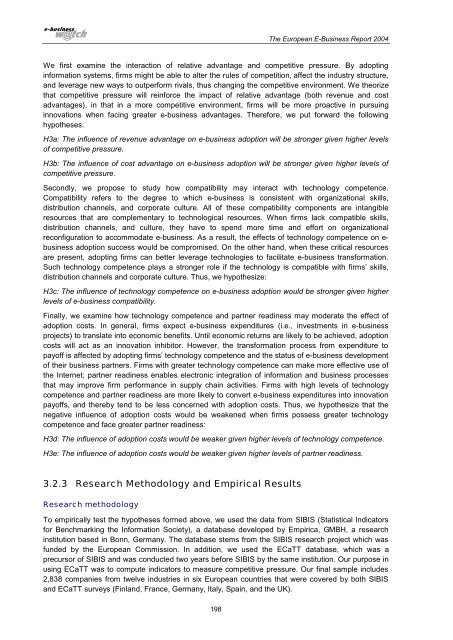The European e-Business Report 2004 - Berlecon Research GmbH
The European e-Business Report 2004 - Berlecon Research GmbH
The European e-Business Report 2004 - Berlecon Research GmbH
You also want an ePaper? Increase the reach of your titles
YUMPU automatically turns print PDFs into web optimized ePapers that Google loves.
<strong>The</strong> <strong>European</strong> E-<strong>Business</strong> <strong>Report</strong> <strong>2004</strong>We first examine the interaction of relative advantage and competitive pressure. By adoptinginformation systems, firms might be able to alter the rules of competition, affect the industry structure,and leverage new ways to outperform rivals, thus changing the competitive environment. We theorizethat competitive pressure will reinforce the impact of relative advantage (both revenue and costadvantages), in that in a more competitive environment, firms will be more proactive in pursuinginnovations when facing greater e-business advantages. <strong>The</strong>refore, we put forward the followinghypotheses:H3a: <strong>The</strong> influence of revenue advantage on e-business adoption will be stronger given higher levelsof competitive pressure.H3b: <strong>The</strong> influence of cost advantage on e-business adoption will be stronger given higher levels ofcompetitive pressure.Secondly, we propose to study how compatibility may interact with technology competence.Compatibility refers to the degree to which e-business is consistent with organizational skills,distribution channels, and corporate culture. All of these compatibility components are intangibleresources that are complementary to technological resources. When firms lack compatible skills,distribution channels, and culture, they have to spend more time and effort on organizationalreconfiguration to accommodate e-business. As a result, the effects of technology competence on e-business adoption success would be compromised. On the other hand, when these critical resourcesare present, adopting firms can better leverage technologies to facilitate e-business transformation.Such technology competence plays a stronger role if the technology is compatible with firms’skills,distribution channels and corporate culture. Thus, we hypothesize:H3c: <strong>The</strong> influence of technology competence on e-business adoption would be stronger given higherlevels of e-business compatibility.Finally, we examine how technology competence and partner readiness may moderate the effect ofadoption costs. In general, firms expect e-business expenditures (i.e., investments in e-businessprojects) to translate into economic benefits. Until economic returns are likely to be achieved, adoptioncosts will act as an innovation inhibitor. However, the transformation process from expenditure topayoff is affected by adopting firms’technology competence and the status of e-business developmentof their business partners. Firms with greater technology competence can make more effective use ofthe Internet; partner readiness enables electronic integration of information and business processesthat may improve firm performance in supply chain activities. Firms with high levels of technologycompetence and partner readiness are more likely to convert e-business expenditures into innovationpayoffs, and thereby tend to be less concerned with adoption costs. Thus, we hypothesize that thenegative influence of adoption costs would be weakened when firms possess greater technologycompetence and face greater partner readiness:H3d: <strong>The</strong> influence of adoption costs would be weaker given higher levels of technology competence.H3e: <strong>The</strong> influence of adoption costs would be weaker given higher levels of partner readiness.3.2.3 <strong>Research</strong> Methodology and Empirical Results<strong>Research</strong> methodologyTo empirically test the hypotheses formed above, we used the data from SIBIS (Statistical Indicatorsfor Benchmarking the Information Society), a database developed by Empirica, GMBH, a researchinstitution based in Bonn, Germany. <strong>The</strong> database stems from the SIBIS research project which wasfunded by the <strong>European</strong> Commission. In addition, we used the ECaTT database, which was aprecursor of SIBIS and was conducted two years before SIBIS by the same institution. Our purpose inusing ECaTT was to compute indicators to measure competitive pressure. Our final sample includes2,838 companies from twelve industries in six <strong>European</strong> countries that were covered by both SIBISand ECaTT surveys (Finland, France, Germany, Italy, Spain, and the UK).198
















